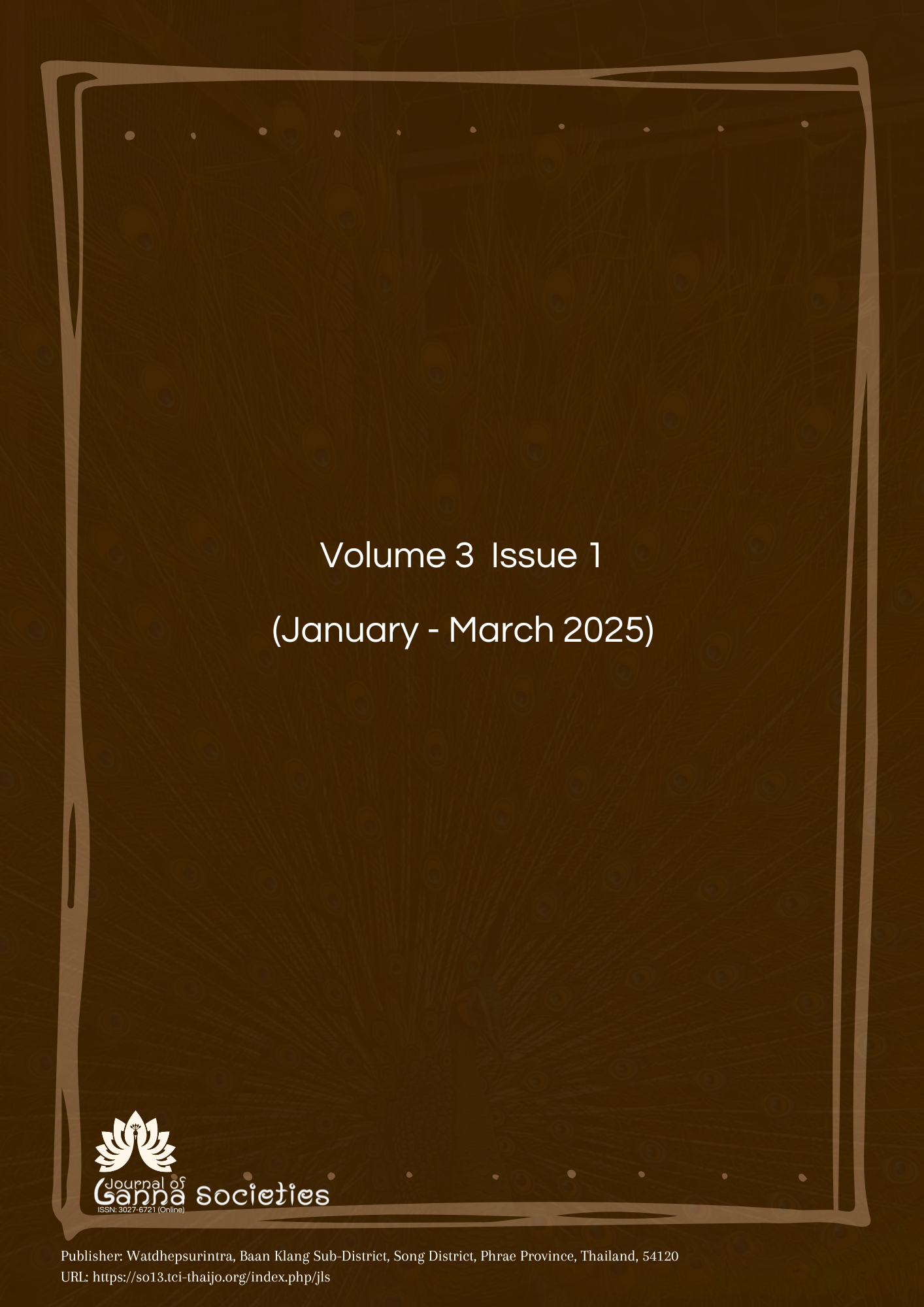Improving The Quality of Health of The Elderly by Using Local Wisdom as The Base Thung Kwao Subdistrict, Mueang Phrae District, Phrae Province
การพัฒนาคุณภาพสุขภาวะของผู้สูงอายุโดยการใช้ภูมิปัญญาพื้นบ้านเป็นฐานของตำบลทุ่งกวาว อำเภอเมืองแพร่ จังหวัดแพร่
Keywords:
Tungkwaw Subdistrict Municipality, Phrae Province, folk wisdom, Area DevelopmentAbstract
The objectives of this research are as follows: 1) To study the health knowledge of the elderly using local wisdom as a base of Thung Kwao Subdistrict. Mueang Phrae District, Phrae Province. 2) To analyze factors affecting the quality of health of the elderly using the local wisdom as a basis of Thung Kwao Subdistrict. Mueang Phrae District, Phrae Province. And 3) To study ways to develop the quality of health of the elderly using local wisdom as a basis of Thung Kwao Subdistrict. Mueang Phrae District, Phrae Province. Use a combined research method. by quantitative research Data were collected from 291 elderly people in Thung Kwao Subdistrict. and qualitative The researcher interviewed people involved with the elderly in Thung Kwao Subdistrict. Mueang Phrae District, Phrae Province, 18 photos or people, structured in-depth interviews. Data were analyzed using descriptions. To answer the research objectives
The results of the study found that:
1. Knowledge of the health of the elderly using folk wisdom as the base of Thung Kwao Subdistrict, Mueang Phrae District, Phrae Province, as follows: 1) Elderly people use local herbs. Have knowledge about the use of herbs to treat and maintain health. To be able to take care of yourself Reduce dependency on modern medicine 2) local food Consuming nutritious foods such as brown rice and fresh vegetables Affects health Encourage the elderly to cook food from local ingredients. 3) Support from family and community Good relationships in family and community help build morale for the elderly. Have a feeling that you are valuable and reduce loneliness. 4) Participating in activities such as gardening or exercising. 5) Passing on wisdom Exchanging knowledge and experiences between generations. 6) Taking care of the mind, participating in religious activities. Make the elderly feel calm and happy. 7) Access to health services Health officials provide knowledge about local herbs. Create a health care network with community leaders
2. Factors affecting the health of the elderly in Thung Kwao Subdistrict, Mueang Phrae District, Phrae Province, overall are at a high level. (=3.66) When considering each aspect, it was found that it was at a high level in every aspect as follows: social support (
=3.74) Groups and communities supporting exercise, perception (
=3.71) about the results of exercise, attitude (
=3.60) exercise is important to health. and knowledge (
=3.58) about exercise, respectively.
3. Guidelines for improving the quality of health of the elderly using local wisdom as a basis of Thung Kwao Subdistrict. Mueang Phrae District, Phrae Province as follows: 1) Physical health Using local herbs in health care traditional exercise Eating the right food. 2) For mental health, go to temples and practice Dhamma. Work related to local wisdom Involving the elderly in family and community activities helps them feel like they are part of society. Valuable and proud. 3) Emotional health Meditation and prayer create a peaceful environment. Organizing cooking activities or traditions together helps strengthen relationships in the community. Make the elderly feel a role and importance in society and have happiness through religious activities. 4) Spiritual health Training in meditation, mindfulness training, participation in religious activities such as praying, making merit, and listening to Dhamma. Participating in traditional activities can connect with local culture and traditions. Helps connect between the elderly and the community It gives a feeling of being part of the community. Feeling valued and important in society Life has meaning Promote good mental health
References
กองสถิติพยากรณ์ สำนักงานสถิติแห่งชาติ. (2564). สถานการณ์ผู้สูงอายุไทยในมิติความต่างเชิงพื้นที่ พ.ศ.2564. สำนักงานสถิติแห่งชาติ กระทรวงดิจิตัลเพื่อเศรษฐกิจและสังคม พิมพ์ครั้งที่ 1. กรุงเทพมหานคร : กองสถิติพยากรณ์ สำนักงานสถิติแห่งชาติ พิมพ์เผยแพร่.
เกสร สำเภาทอง. (2549). การพัฒนาคุณภาพชีวิตผู้สูงอายุตามแนวทางเศษฐกิจพอเพียงและการมีส่วนร่วมของชุมชน จังหวัดปทุมธานี. บทความวิชาการ. วารสารพยาบาลและการดูแลสุขภาพ. ปีที่ 34 ฉบับที่ 2. 2549.
ฐิตินันท์ นาคผู้และอาจินต์ สงทับ. (2562). วารสารวิชาการมหาวิทยาลัยอิสเทิร์นเอเชีย ฉบับวิทยาศาสตร์และเทคโนโลยี. ปีที่ 13 ฉบับที่ 1 ประจำเดือน มกราคม-เมษายน 2562.
ทรงศิริ สาประเสริฐ. (2542). ลักษณะการถ่ายทอดความรู้ของภูมิปัญญาชาวบ้าน. วิทยานิพนธ์. กรุงเทพมหานคร:
บรรลุ ศิริพานิช. (2538). คู่มือผู้สูงอายุ ฉบับสมบูรณ์. กรุงเทพมหานคร: โรงพิมพ์หมอชาวบ้าน.
บรรลุ ศิริพานิช. (2542). ผู้สูงอายุไทย. พิมพ์ครั้งที่ 2. กรุงเทพมหานคร: สภาผู้สูงอายุแห่งประเทศไทย.
ประภาศิริ กลางพอน. (2567). ภูมิปัญญาท้องถิ่นภูมิปัญญาไทย. [ระบบออนไลน์]. แหล่งที่มาttp://www.ipesp.ac.th/learning/thaistory/index.html.
ปริญญาภรณ์ ธนะบุญปวง. (2565). การดูแลสุขภาวะและคุณภาพชีวิตผู้สูงอายุในยุคปกติถัดไป. วารสารวิจัยเพื่อการส่งเสริมสุขภาพและคุณภาพชีวิต. ปีที่ 2 ฉบับที่ 1 มกราคม– เมษายน 2565.
ปาริชาติ คุณปลื้ม. (2565). การปรับตัวของผู้สูงอายุไทยในยุคโควิด-19. วารสารวิชาการศรีปทุม ชลบุรี ปีที่ 18 ฉบับที่ 4 เดือนเมษายน-เดือนมิถุนายน 2565.
พัชรินทร์ สิรสุนทร. (2552). ชุมชนปฏิบัติการด้านการเรียนรู้ : แนวคิดเทคนิคและวิธีการ. กรุงเทพมหานคร: สำนัก พิมพ์แห่งจุฬาลงกรณ์มหาวิทยาลัย.
สมศักดิ์ ศรีสันติสุข. (2539). สังคมวิทยาภาวะสูงอายุ: ความเป็นจริงและการคาดการณ์ในสังคมไทย.กรุงเทพมหานคร: จุฬาลงกรณ์มหาวิทยาลัย.
สำนักงานพัฒนาชุมชนจังหวัดแพร่. (2565). รายงานพัฒนาคุณภาพชีวิตของประชาชนจังหวัดแพร่ ประจำปี พ.ศ.2565. เอกสารอัดสำเนา.
สุนิสา ค้าขึ้น. (2563). ภาวะสุขภาพจิตและปัจจัยที่เกี่ยวข้องในผู้สูงอายุ. บทความวิจัย. วารสารวิจัยสุขภาพและการพยาบาล ปีที่ 36 ฉบับที่ 3 กันยายน - ธันวาคม 2563.
อนงค์ศิริ วิชาลัย. (2544). หลักสูตรและกระบวนการเรียนการสอน. เชียงใหม่: คณะครุศาสตร์ มหาวิทยาลัยราชภัฎเชียงใหม่.
เอกวิทย์ ณ ถลาง. (2544). ภูมิปัญญาภาคกลาง. พิมพ์ครั้งที่ 2. กรุงเทพมหานคร: อมรินทร์ฒ.
Downloads
Published
How to Cite
Issue
Section
License
Copyright (c) 2025 Journal of Lanna Societies

This work is licensed under a Creative Commons Attribution-NonCommercial-NoDerivatives 4.0 International License.





